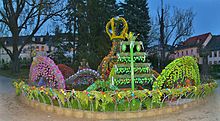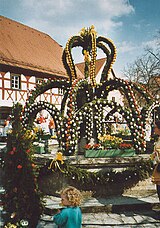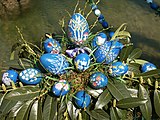Easter fountain
Originally from Franconian Switzerland , the custom of decorating public village fountains with painted Easter eggs and other decorations as Easter fountains has spread in large parts of southern, central and eastern Germany since the 1980s.
The arrangement of the eggs usually reminiscent of the shape of a crown and is therefore also Easter crown called. This is not used everywhere to decorate a fountain, but is also hung or set up in other suitable public places.
Time and places with Easter fountain
Usually, the Easter fountains in the communities are decorated from Palm Sunday (traditionally only from Holy Saturday) and remain so until two weeks after Easter. During this time, the places with the Easter fountain, which are particularly beautiful, are popular tourist destinations. The fountains in Heiligenstadt , Bieberbach or Schechingen in Baden-Württemberg in particular are now considered to be tourist attractions that are visited by numerous bus tour groups from Munich, Dresden, Stuttgart and other major cities. In Heiligenstadt, around 80 buses were counted on a single day.
Easter fountain in Tiefenpölz (2009)
Easter fountain in Münchsteinach (2010)
Easter Fountain in Saviors (2014)
Easter fountain in front of Thurnau Castle (2015)
Icy Easter fountain in front of Fantaisie Palace in Eckersdorf (2013)
Easter fountain in Franconian Switzerland

Historical background
Unsecured oral traditions report for the first time about an Easter fountain in Aufseß around 1909. The reasons for the origin of the custom of the Easter fountain decoration in Franconian Switzerland are unclear. In addition to Christian interpretations, the water poverty in Franconian Switzerland is often cited as an explanation, as a result of which water supply was of particular importance. The thorough cleaning of the fountains and springs, which are important for the drinking water supply, from the dirt of autumn and winter, mostly carried out in collaboration, has also repeatedly been associated with the emergence of the Easter fountain. Much more likely, however, is that the Easter fountain will be touristically oriented from the start. In Franconian Switzerland, and especially in the region around Muggendorf, which was closely linked to the appearance of the Easter wells around 1910, there was already lively tourism activity from the early 19th century. The Easter wells developed into a magnet for visitors shortly after they were first mentioned in the otherwise rather low-visitor spring season.
The first (incorrect) interpretations of the Easter wells as remnants of Slavic or Wendish “pagan customs” came as early as the 1920s. In the 1930s, these ideas were partially adopted by regional Nazi propaganda and the Easter fountains were reinterpreted as a “Germanic” custom with ancient roots in the “source cult of our ancestors”. Probably because they were ascribed Slavic origins and because they were still not widespread compared to today, the Easter fountains received less attention and were used less for Nazi propaganda.
The rationing of eggs, the decline in tourism and the loss of importance of the wells due to modern water supply systems caused the custom of the Easter wells to decline significantly during and after the Second World War . In order to save the supposedly “old” custom from extinction, from 1952 the Nuremberg doctor and castle researcher Hellmut Kunstmann worked together with his wife for the continued existence of the Easter fountain. This commitment, together with the tourist marketing of the Osterbrunnen, which started again in the post-war years, resulted in the adoption of the "custom" in numerous other communities in Franconian Switzerland and beyond in the following years. As early as the 1920s and 1930s, starting from Franconian Switzerland , the Easter wells spread - albeit briefly - to other parts of Bavaria and neighboring Thuringia. However, the fountains only became more and more popular in the 1970s and 1980s. Easter bus tours by tourist groups to the Easter fountains in Franconian Switzerland and in large parts of southern Germany have become an important source of income for local and regional tourism and catering companies.
Easter fountain outside of Franconian Switzerland
Since the 1980s, Easter fountains have also spread outside of Franconian Switzerland . There are now Easter wells in large parts of Bavaria , Hesse , Thuringia , Saxony , Rhineland-Palatinate and Saarland . In particular, the Baden-Württemberg towns of Schechingen and Oberstadion , which, in addition to an Easter museum, are also building Germany's largest Easter fountain with almost 27,000 eggs (as of 2014), have established themselves as centers of Easter fountain tourism outside of Franconia in recent years .
Since the mid-2000s, the spread of Easter fountains to the north has also been observed in isolated cases. In 2006 the city marketing department of Haselünne in Emsland introduced the decoration of the local fountains and pumps.
Lower Franconia: Easter fountain in Miltenberg
South Hesse: Easter fountain in Michelstadt
Swabia: Easter fountain in front of the Hüle in Bartholomä
Saarland : Easter fountain in St. Wendel
Lower Saxony: Easter fountain in Haselünne (Emsland)
Competition between the Osterbrunnen locations
Against the background of increasing competition for limited numbers of visitors, an escalating competition developed among the Easter fountain locations for the largest, most beautiful and "most authentic" Easter fountain. The fountain in Bieberbach, Franconia, which was decorated with 11,108 hand-painted eggshells in 2001, lost its entry in the Guinness Book of Records as the largest Easter fountain in 2005 to Sulzbach-Rosenberg in Upper Palatinate , where the city fountain there was decorated with 16,500 eggs. In 2014, the Upper Swabian community of Oberstadion surpassed this record and is also aiming for an entry in the Guinness Book of Records with its Easter fountain, which currently has almost 27,000 eggs.
Easter fountain in Bieberbach
Osterbrunnen Bunny School in Bieberbach April 2004; Figures based on "The Bunny School" by Albert Sixtus (author) and Fritz Koch-Gotha (illustrator)
Record fountain from Sulzbach-Rosenberg in 2005
Record attempt well in the upper stadium

Modifications
Other facilities close to the water are occasionally decorated like Easter fountains, e.g. B. Bridges over waters and springs.
vandalism
Due to the wanton and sometimes deliberate destruction of the egg decorations, the blown-out chicken eggs that were originally painted in laborious manual labor have now been replaced by less susceptible plastic eggs in many communities.
Origin of the Easter fountain
Recent research has shown that the Franconian Easter wells are a deliberate recreation of customs from the late 19th or early 20th century, closely related to tourism considerations. According to unconfirmed oral records, the origin of the Easter wells is usually given around 1909 in the small community of Aufseß (Franconian Switzerland). In contrast, the first written evidence in 1913 shows Engelhardsberg near Muggendorf (now part of the Wiesenttal community) as the place of origin. Despite numerous investigations, no conclusive evidence of an older origin of the custom or connections with other, older customs in the region has been found. Nevertheless, historically and scientifically untenable theories and assumptions about a pagan or medieval origin of the Easter fountain appear again and again in numerous newspaper articles, information brochures, on the homepages of the Osterbrunnen communities, in tourist guides or in publications, some of which are self-appointed local researchers. In addition to (mostly covert) quotations from National Socialist literature, the considerations of Claudia Schillinger and Karl Weinhold, which are now considered obsolete, are given as evidence .
Unsustainable theories about the origin of the Easter fountain
Claudia Schillinger: Franconian Easter wells
In the illustrated book Fränkische Osterbrunnen , first published in 1997 and based on an approval work by Bamberg's teacher training student Claudia Schillinger , it is claimed that the Easter fountains went back to "pagan origins". Claudia Schillinger interprets the Easter wells as "remnants of Wendish superstition". It is based on theories of the early 20th century on the survival of Slavic traditions in Upper Franconia, which are considered outdated, with a single high-medieval source in which the Franconian "landlord" Mahkorn demanded in a decree that "fountains and springs at Easter with fresh [ Spring?] - should be decorated in green because spring is coming ”, Schillinger tried to prove that there were Easter fountains even then . However, it made no effort to clarify the historical context for the event described in the document. It therefore remains unclear which event was involved, whether it took place several times, which fountains were decorated, or whether the event was part of other activities or customary events. Schillinger justifies the fact that other historical records about the decoration of fountains in Upper Franconia are almost completely absent with the suppression of the custom by Christianity, which makes it "barely comprehensible" historically.
Thuringian source cults from Karl Weinhold

Another source cited by proponents of the pagan origin of the Osterbrunnen is the essay by Karl Weinhold published in 1898 under the title The Adoration of Sources in Germany . Weinhold describes that “in Thuringia, one of the main signs of the old fountain cult was to clean the fountain and decorate it with fresh green. According to Weinhold, the purification was carried out by the local virgins with prayer and song, whereby no man was allowed to be present. The cleaning had to be finished by sunrise. The fountain was then wreathed and the fairground was decorated. Afterwards the congregation gathered to dance and play ”. In this essay, Weinhold does not name the exact places or the time where and when what he describes should have happened, which is why his descriptions are largely criticized as his own speculations according to hearsay. At most, Weinhold mentions decorating fountains in Thuringia, without mentioning the term Easter fountain.
literature
- Gerhard Köhler: Franconian Easter fountains and Easter crowns. Books on Demand, Norderstedt 2015, ISBN 978-3-7347-9039-3 .
- Claudia Schillinger: Franconian Easter wells - folk custom and folk art. 3. Edition. Heinrichs-Verlag, Bamberg 2002, ISBN 978-3-89889-064-9 .
- Claudia Schillinger: Osterbrunnen - spread of an Upper Franconian tradition. Bayerische Verlagsanstalt, Bamberg 1991, ISBN 978-3-87052-418-0 .
Web links
- Traditional and artistic: these are the Easter fountains in Franconia . In: Nordbayern.de
- Easter fountain in Amberg-Sulzbacher Land
- Easter fountain in Forchheim and Upper Franconia
- Osterbrunnen Niederalbertsdorf
Individual evidence
- ^ Rhein-Erft-Umschau of March 22, 2008: Blessem. Put the crown on Easter
- ↑ a b c History of the Osterbrunnen - With a list of the Osterbrunnenorte . Franconian Switzerland. Retrieved April 8, 2012.
- ↑ a b Easter in Germany ( English ) Journey to Germany. Archived from the original on January 3, 2013. Info: The archive link was inserted automatically and has not yet been checked. Please check the original and archive link according to the instructions and then remove this notice. Retrieved April 8, 2012.
- ↑ Haselünner Easter Fountain 2006 . City of Haselünne. 2006. Retrieved April 8, 2012.
- ^ Easter fountain in Franconian Switzerland . Heiligenstadt market. Retrieved April 8, 2012.
- ^ Ingrid Sachsenmaier: Oberstadion: record attempt with Easter fountain. Stuttgarter Nachrichten newspaper , April 19, 2014, accessed on April 22, 2014 .
- ↑ Karl Weindold: The worship of sources in Germany . Holy springs. Retrieved April 8, 2012.



















